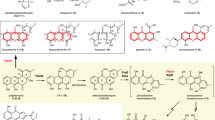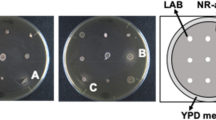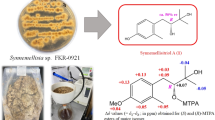Abstract
SINCE the discovery that riboflavin is produced by Eremothecium ashbyii and Ashbya gossypii 1, a great number of bacteria and fungi have been found capable of producing this and other closely related substances2. Among the Actinomycetales only a few species of Mycobacterium 3 have been reported capable of producing riboflavin, while no true Actinomycete has ever been found to possess such a capacity.
This is a preview of subscription content, access via your institution
Access options
Subscribe to this journal
Receive 51 print issues and online access
$199.00 per year
only $3.90 per issue
Buy this article
- Purchase on Springer Link
- Instant access to full article PDF
Prices may be subject to local taxes which are calculated during checkout
Similar content being viewed by others
References
Guilliermond, A., Fontaine, M., and Raffy, A., C.R. Acad. Sci., Paris, 201, 1077 (1935).
Peterson, W. M., and Peterson, M. S., Bact. Rev., 9, 49 (1945). Van Lanen, J. M., and Tanner, F. W., Vitamins and Hormones, 6, 163 (1948). Pridham, T. G., Econ. Bot., 6, 185 (1952).
Mayer, R. L., and Rodbart, M., Arch. Biochem., 11, 49 (1946). Smith, M. I., and Emmart, E. W., J. Immunol., 61, 259 (1949).
Crammer, J. L., Nature, 161, 349 (1948).
Author information
Authors and Affiliations
Rights and permissions
About this article
Cite this article
CIFERRI, O., MACHADO, M. Isolation of a New Flavin produced by an Actinomycete. Nature 181, 484–485 (1958). https://doi.org/10.1038/181484b0
Issue Date:
DOI: https://doi.org/10.1038/181484b0
This article is cited by
-
The effect of some inhibitors on streptomycin biosynthesis
Folia Microbiologica (1959)
Comments
By submitting a comment you agree to abide by our Terms and Community Guidelines. If you find something abusive or that does not comply with our terms or guidelines please flag it as inappropriate.



